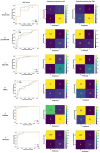Multi-Dataset Comparison of Vision Transformers and Convolutional Neural Networks for Detecting Glaucomatous Optic Neuropathy from Fundus Photographs
- PMID: 38002390
- PMCID: PMC10669064
- DOI: 10.3390/bioengineering10111266
Multi-Dataset Comparison of Vision Transformers and Convolutional Neural Networks for Detecting Glaucomatous Optic Neuropathy from Fundus Photographs
Abstract
Glaucomatous optic neuropathy (GON) can be diagnosed and monitored using fundus photography, a widely available and low-cost approach already adopted for automated screening of ophthalmic diseases such as diabetic retinopathy. Despite this, the lack of validated early screening approaches remains a major obstacle in the prevention of glaucoma-related blindness. Deep learning models have gained significant interest as potential solutions, as these models offer objective and high-throughput methods for processing image-based medical data. While convolutional neural networks (CNN) have been widely utilized for these purposes, more recent advances in the application of Transformer architectures have led to new models, including Vision Transformer (ViT,) that have shown promise in many domains of image analysis. However, previous comparisons of these two architectures have not sufficiently compared models side-by-side with more than a single dataset, making it unclear which model is more generalizable or performs better in different clinical contexts. Our purpose is to investigate comparable ViT and CNN models tasked with GON detection from fundus photos and highlight their respective strengths and weaknesses. We train CNN and ViT models on six unrelated, publicly available databases and compare their performance using well-established statistics including AUC, sensitivity, and specificity. Our results indicate that ViT models often show superior performance when compared with a similarly trained CNN model, particularly when non-glaucomatous images are over-represented in a given dataset. We discuss the clinical implications of these findings and suggest that ViT can further the development of accurate and scalable GON detection for this leading cause of irreversible blindness worldwide.
Keywords: deep learning; fundus photography; glaucoma; vision transformer.
Conflict of interest statement
The authors declare no conflict of interest.
Figures




Similar articles
-
Development and Validation of a Deep Learning System to Detect Glaucomatous Optic Neuropathy Using Fundus Photographs.JAMA Ophthalmol. 2019 Dec 1;137(12):1353-1360. doi: 10.1001/jamaophthalmol.2019.3501. JAMA Ophthalmol. 2019. PMID: 31513266 Free PMC article.
-
Deep learning-based automated detection of glaucomatous optic neuropathy on color fundus photographs.Graefes Arch Clin Exp Ophthalmol. 2020 Apr;258(4):851-867. doi: 10.1007/s00417-020-04609-8. Epub 2020 Jan 27. Graefes Arch Clin Exp Ophthalmol. 2020. PMID: 31989285
-
Detecting glaucoma from multi-modal data using probabilistic deep learning.Front Med (Lausanne). 2022 Sep 29;9:923096. doi: 10.3389/fmed.2022.923096. eCollection 2022. Front Med (Lausanne). 2022. PMID: 36250081 Free PMC article.
-
Do it the transformer way: A comprehensive review of brain and vision transformers for autism spectrum disorder diagnosis and classification.Comput Biol Med. 2023 Dec;167:107667. doi: 10.1016/j.compbiomed.2023.107667. Epub 2023 Nov 3. Comput Biol Med. 2023. PMID: 37939407 Review.
-
Advancing glaucoma detection with convolutional neural networks: a paradigm shift in ophthalmology.Rom J Ophthalmol. 2023 Jul-Sep;67(3):222-237. doi: 10.22336/rjo.2023.39. Rom J Ophthalmol. 2023. PMID: 37876506 Free PMC article. Review.
Cited by
-
Meeting Challenges in the Diagnosis and Treatment of Glaucoma.Bioengineering (Basel). 2024 Dec 25;12(1):6. doi: 10.3390/bioengineering12010006. Bioengineering (Basel). 2024. PMID: 39851280 Free PMC article.
-
Application of artificial intelligence in glaucoma care: An updated review.Taiwan J Ophthalmol. 2024 Sep 13;14(3):340-351. doi: 10.4103/tjo.TJO-D-24-00044. eCollection 2024 Jul-Sep. Taiwan J Ophthalmol. 2024. PMID: 39430354 Free PMC article. Review.
-
Generative Artificial Intelligence Enhancements for Reducing Image-based Training Data Requirements.Ophthalmol Sci. 2024 Apr 14;4(5):100531. doi: 10.1016/j.xops.2024.100531. eCollection 2024 Sep-Oct. Ophthalmol Sci. 2024. PMID: 39071920 Free PMC article.
-
Explainable Deep Learning for Glaucomatous Visual Field Prediction: Artifact Correction Enhances Transformer Models.Transl Vis Sci Technol. 2025 Jan 2;14(1):22. doi: 10.1167/tvst.14.1.22. Transl Vis Sci Technol. 2025. PMID: 39847375 Free PMC article.
-
CA-ViT: Contour-Guided and Augmented Vision Transformers to Enhance Glaucoma Classification Using Fundus Images.Bioengineering (Basel). 2024 Aug 31;11(9):887. doi: 10.3390/bioengineering11090887. Bioengineering (Basel). 2024. PMID: 39329629 Free PMC article.
References
Grants and funding
LinkOut - more resources
Full Text Sources

